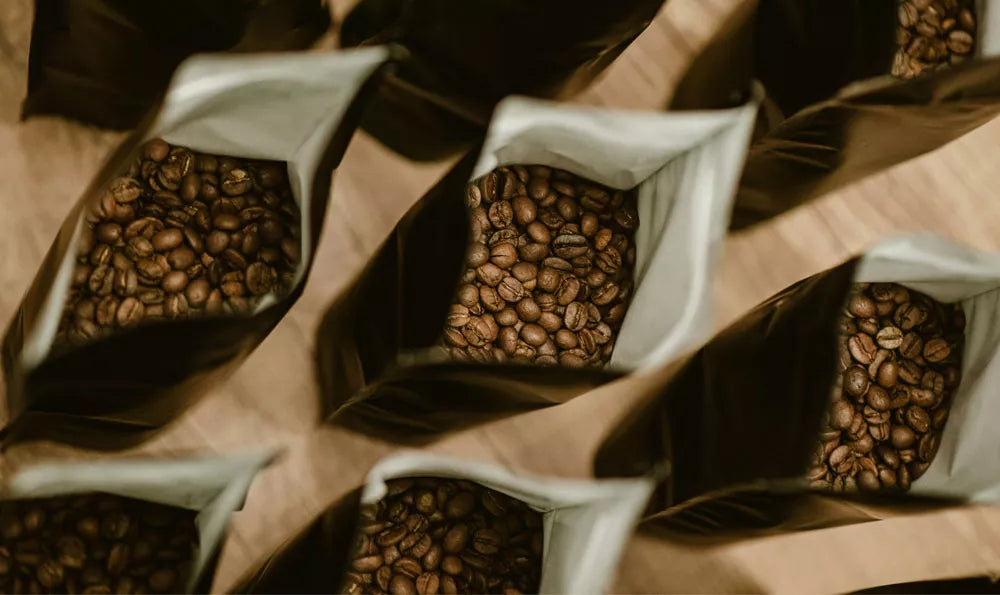
How Coffee Packaging Impacts Flavor and Freshness
Share
The way coffee is packaged plays a crucial role in preserving its flavor and freshness. Proper packaging prevents exposure to oxygen, light, and moisture—the primary culprits of coffee degradation—ensuring that every cup you brew tastes as fresh as intended.
Why Coffee Packaging Matters

Coffee is a sensitive product. Once roasted, coffee beans and grounds release oils and aromatic compounds that give your brew its signature taste and aroma. However, these compounds are volatile and degrade when exposed to external factors like air, light, and humidity. Without effective packaging, coffee quickly loses its freshness, leaving you with a dull and lifeless cup.
At Milk & Honey Coffee, we understand that the journey from farm to cup involves more than just sourcing the best beans—it’s about protecting their quality until they reach your hands.
What Makes Coffee Flavorful?

Coffee’s flavor comes from a complex mix of oils, acids, and over 800 aromatic compounds. These elements are highly sensitive to environmental changes. Oxidation—the process of oxygen interacting with these compounds—is one of the leading causes of flavor loss. Similarly, exposure to moisture can make coffee go stale, while light can cause photodegradation, altering its taste profile.
How Does Packaging Protect Coffee?
Effective coffee packaging acts as a barrier against these external factors:
- Oxygen: Airtight seals prevent oxidation.
- Moisture: Barrier layers keep humidity at bay.
- Light: Opaque materials protect against UV damage.
- Temperature Fluctuations: Insulating materials stabilize the coffee’s environment.
Common Coffee Packaging Methods
Vacuum-Sealed Bags

Benefits:
- Great for long-term storage.
- Keeps oxygen out completely.
Limitations:
- Less effective for freshly roasted coffee, as it doesn’t allow degassing.
One-Way Valve Bags

These bags feature a valve that lets carbon dioxide escape without letting oxygen in. This makes them ideal for freshly roasted coffee that continues to release gases.
Benefits:
- Preserves freshness without bloating the bag.
- Commonly used in specialty coffee.
Airtight Containers

Reusable containers made from materials like glass, metal, or plastic provide a robust barrier against environmental factors.
Benefits:
- Eco-friendly options available.
- Long-lasting and durable.
Limitations:
- Require proper cleaning to avoid residue buildup.
Innovative Packaging Technologies
Nitrogen-Flushed Packaging

This method replaces oxygen with nitrogen, an inert gas, to extend shelf life. It’s widely used by premium coffee brands like Milk & Honey Coffee to lock in freshness.
Advantages:
- Prevents oxidation for months.
- Ideal for large-scale distribution.
Eco-Friendly Packaging

Sustainability is a growing trend in coffee packaging. Biodegradable and compostable materials provide an eco-conscious solution without compromising quality.
Examples:
- Compostable one-way valve bags.
- Recyclable aluminum-lined pouches.
Environmental Impact of Coffee Packaging

Traditional coffee packaging often involves plastics and aluminum, which are difficult to recycle. Sustainable alternatives not only reduce waste but also appeal to environmentally conscious consumers.
Milk & Honey Coffee’s Commitment to Sustainability
We’re proud to use packaging that balances freshness with environmental responsibility, ensuring that your coffee experience aligns with your values.
Consumer Perceptions of Coffee Packaging

Aesthetics and Freshness
Beautifully designed packaging doesn’t just catch the eye—it communicates quality and freshness. Consumers often associate premium packaging with superior taste.
Branding and Loyalty
Packaging is a powerful branding tool. At Milk & Honey Coffee, we prioritize designs that reflect our dedication to quality and sustainability, fostering trust and loyalty among our customers.
Economic Considerations in Coffee Packaging

The cost of coffee packaging varies based on materials, technologies, and sustainability. While premium options like nitrogen-flushed or biodegradable bags are more expensive, they offer long-term benefits in preserving freshness and reducing environmental impact.
Best Practices for Consumers
Choosing the Right Packaging
Selecting the right packaging is essential for preserving flavor and freshness. Check out these Best Coffee Packaging Tips to ensure you're making the right choice for your coffee.
When buying coffee, look for:
- One-way valve bags for freshly roasted coffee.
- Airtight containers for long-term storage.
- Sustainable options if environmental impact matters to you.
- Packaging designed to Extend Coffee Shelf Life, such as nitrogen-flushed bags or vacuum-sealed containers.
Storing Coffee at Home
- Keep coffee in a cool, dark place.
- Use airtight containers to maintain freshness.
- Avoid refrigeration unless necessary, as moisture can compromise quality.
Conclusion
Coffee packaging significantly impacts flavor and freshness, just like brewing variables such as grind size, temperature, or Hard Water Coffee Effects — all of which play a critical role in your coffee experience. Whether through innovative technologies or sustainable practices, the right packaging ensures that every sip tastes as good as the day it was roasted. At Milk & Honey Coffee, we’re committed to delivering not just exceptional beans but also the perfect packaging to preserve their quality.
